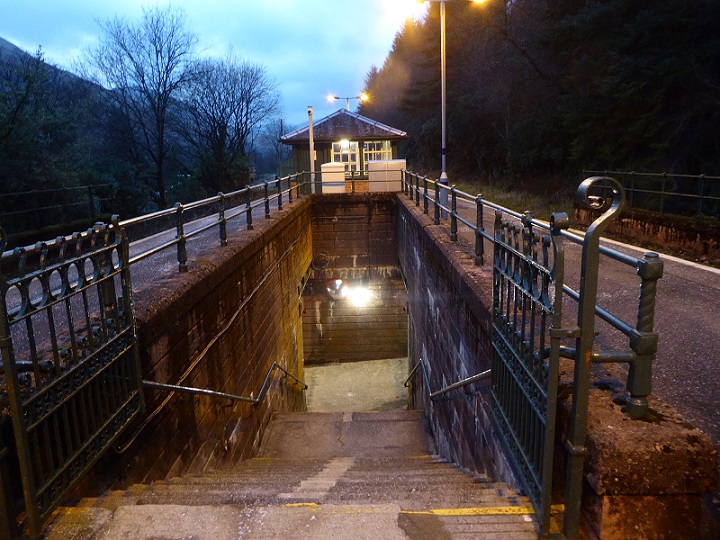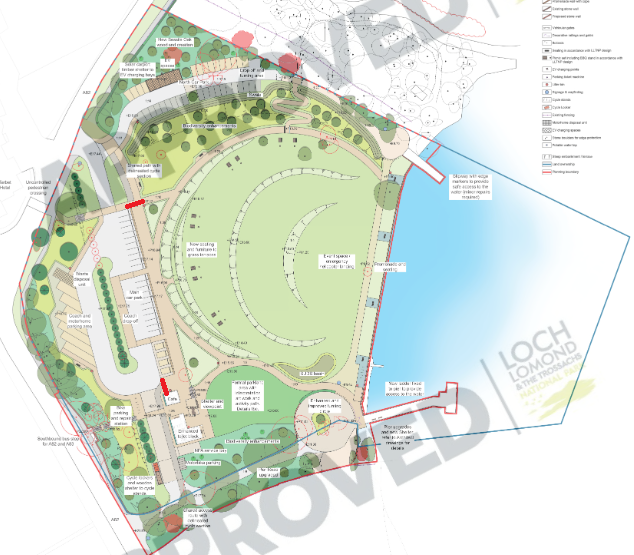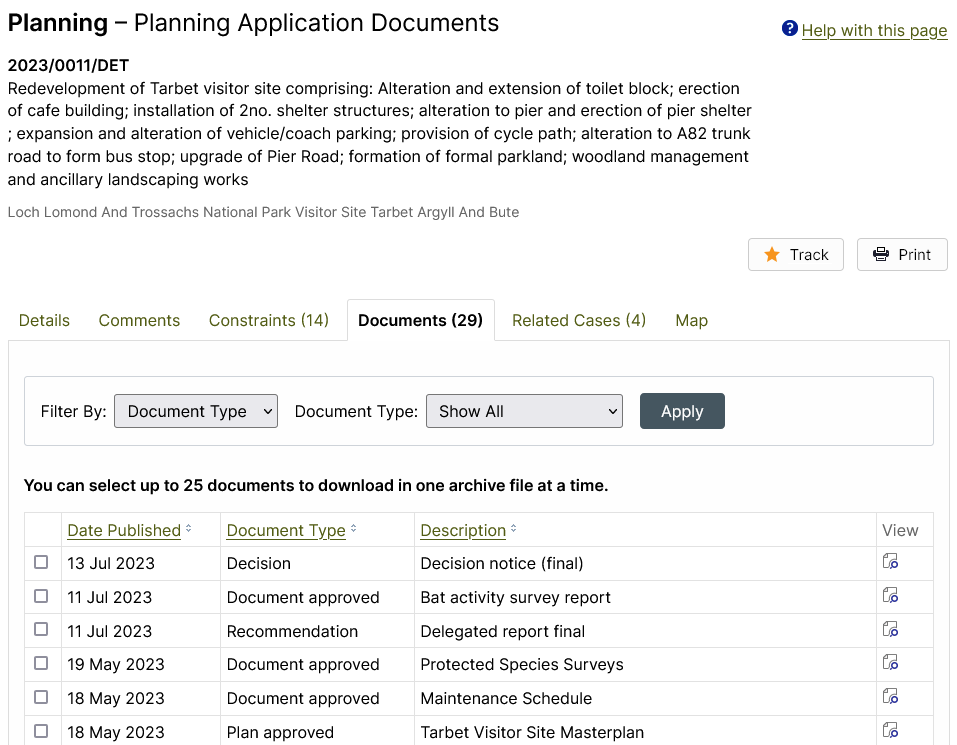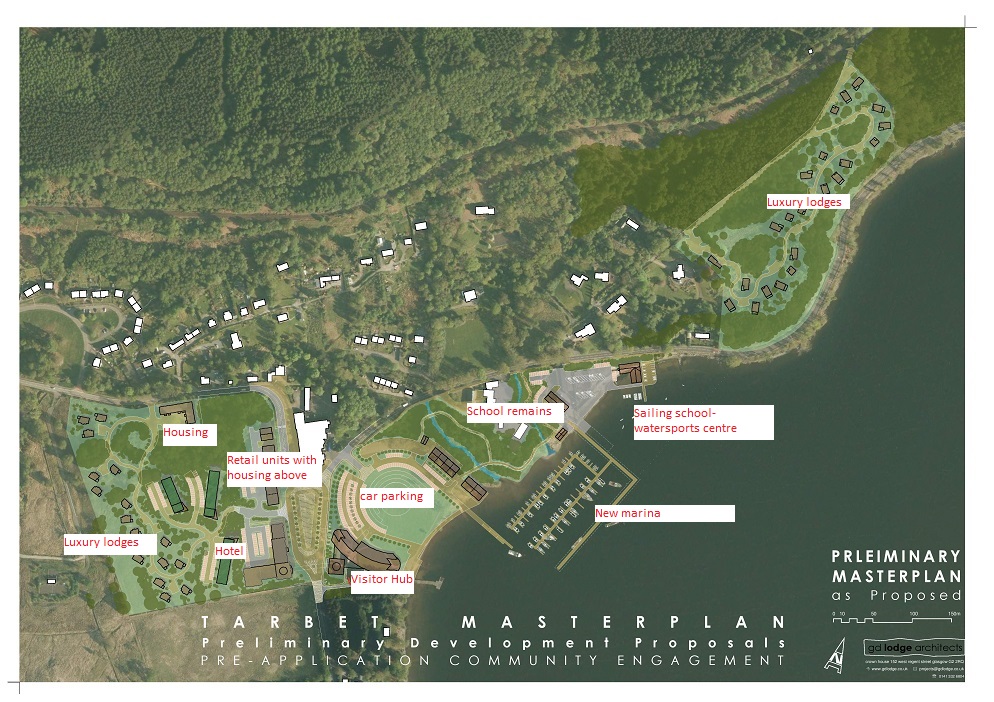On 25th January, Network Rail announced it was extending the platforms on eight stations along the West Highland Line by 15m at a cost of £1.7m to allow trains to run with an extra carriage (see here). The purpose of this investment is to help meet increasing passenger demand and enable the trains to carry bulky luggage and up to 20 bicycles. Three stations in the Loch Lomond and Trossachs National Park are included, Crianlarich, Ardlui and Arrochar & Tarbet where work was scheduled to start on 27th January.
A day later, on 26th January, the Loch Lomond and Trossachs National Park Authority (LLTNPA) announced it was closing the “Tarbet visitor site”, which it owns, as part of a £2.1m upgrade (see here). (The work is partially financed by a £750k grant from VisitScotland’s Rural Tourism Infrastructure Fund which has subsequently been slashed in the Scottish Government’s budget for 2024/25). The stated purpose of the investment is “to establish the site as a sustainable travel hub: a cycle hub with repair station, charging points for electric vehicles and e-bikes, more accessible pedestrian facilities and improved cycling routes.”
Despite the fact that Tarbet railway station and the Tarbet visitor site on the west shore of Loch Lomond are less than 1km apart and both investments are ostensibly about sustainable transport, amazingly neither news release refers to the other. So what is going on?
The LLTNPA and the West Highland Line
The LLTNPA has for a long time taken little to no interest in the potential offered by the West Highland line to provide more sustainable and public transport in the National Park. Seven years ago, for example, I found out through a Freedom of Information that the LLTNPA had not made “any representations to Derek Mackay [then transport Minister and subsequently disgraced] and or Transport Scotland about the proposed reduction in cycling capacity on the trains being refitted for the West Highland Line” (FOI 2016-011 Response cycling)
The LLTNPA, however, knew about Transport Scotland’s about turn on cycling capacity on the West Highland Line and their station upgrade proposals because in October 2023 their planners decided the works including “erection of barriers, gates, handrails and steps” at Arrochar and Tarbet station did not require “prior approval” from them (see here). This was a missed opportunity.
In theory the improvements in carrying capacity on the West Highland Line should make it easier for hillwalkers, for example, to ditch their cars and travel to places like the Arrochar Alps by train and then bike. The distance between the station and the starting point on Loch Long for the very popular path up the Cobbler is far enough to put most people off walking/running but cycling is quite feasible. But anyone now thinking of travelling by train and bike – exactly the type of “active travel” the LLTNPA claims in its draft National Park Partnership Plan (NPPP) that it wishes to promote – faces a major obstacle as soon as they get out the train:

Most hillwalkers of course are reasonably fit and some might be happy carrying their bike back up these stairs at the end of the day. But what about someone who has taken the train to Balloch, cycled out to Tarbet and wants to get the train back? And what about tourists with suitcases trying to take the train as the right thing to do?
The LLTNPA could have used its planning powers under the prior approval system to push Transport Scotland and Network Rail to make further and associated improvements to the stations. This would have also helped to improve access for people with disabilities (something that the LLTNPA has also claimed it wishes to do). There is no evidence on the planning portal however that the LLTNPA’s planners, managed by Stuart Mearns the Director of Place, even raised this issue with Network Rail. That is despite the LLTNPA having committed to the following in its draft National Park Partnership Plan (NPPP) which has now been sent to Lorna Slater the Minister responsible for National Parks for approval:
“Through its planning role the National Park Authority can pro-actively guide new development and infrastructure within the National Park that is more closely aligned to facilitating the land use change required to deliver for climate and nature, while also meeting the needs of those living and working here……………………..
There is also a need to invest in existing rural infrastructure to repair, improve and strengthen its resilience towards the impacts of climate change. The location of the National Park means it hosts nationally strategic infrastructure including the A82, A83, A84 and A85 Trunk Roads, the West Highland rail line, electricity transmission infrastructure and a large hydro-electric power station at Sloy, Loch Lomond.
As well as the ongoing maintenance and investment required for this infrastructure, a number of these assets have also identified or planned improvements supported by NPF4. The design and delivery of these can ensure these also contribute to enhancing the nature and landscape of the National Park.”
This is not only a major failure in governance, the upgrade of the West Highland Line provides early evidence to substantiate my claim last year that the LLTNPA’s NPPP is a completely useless document (see here). It also shows that the LLTNPA, as currently governed and managed, is completely incapable of working with other organisations or delivering any of the changes that we need to address the climate emergency.
The Tarbet Visitor Site
Back in February 2023 Geoff Riddington wrote a critique on parkswatch about the draft masterplan for the site and how it failed outdoor recreation (see here). Very little was altered in the final masterplan (the original is shown in Geoff’s post) before he LLTNPA granted planning approval to itself in July to develop what it now calls the Tarbet Visitor site (see here) (application reference 2023/0011/DE):

The main change is that the section of cycle track which had run round the car park on the pavement – which was contrary to standards for cycle paths and dangerous – has now been removed entirely. Cyclists are now presumably expected to ride through the car park dodging vehicles.
The LLTNPA’s news release claims the investment will transform the site “a sustainable low-carbon destination with expanded facilities for the community and for visitors”. The reality is that much of the re-development is about increasing parking capacity:
- Enlargement of north car park (approx. 20 additional spaces);
- Formation of coach and motorhome parking area in west car park;
- Formation of motorbike parking area;
With the car park overflowing at times, in part because of the LLTNPA’s failure to make proper provision for overnight stays by motorhomes elsewhere, there was no doubt that something needed to be done. The creation of additional parking spaces, however, cannot be described as a green measure, even if six will offer electric vehicle charging (most likely financed through the UK National Parks greenwashing partnership with Mercedes (see here)). The development of additional capacity for vehicles will, however, enable the LLTNPA to raise additional income for itself from parking charges. The real green transport measures are limited to some bike parking, including cycle lockers, and a bike repair station. That is hardly transformational.
Meantime the LLTNPA continues to do anything meaningful to make public transport to the area ( or anywhere else in the National Park) more bike friendly, which is what is needed to get more people cycling in places like Tarbet and Arrochar. Besides their silence on the role the West Highland Line should play in this, they have done nothing to get the bus operators to carry bikes as commonly happens on the continent – a missed tourism opportunity.
In the news release, the LLTNPA’s Director of Place Stuart Mearns also claims: “Tarbet is a gateway to the National Park and the ambitious transformation of this site will benefit all those who use it, from day visitors and campers [my emphasis] to the local community and businesses.” How the site will benefit campers is not explained but the development appears to include no new camping provision. The camping byelaws make camping here informally between 1st March and 30th September a criminal offence raising questions about the purpose of the cycle lockers.
The claim in the LLTNPA news release that the “masterplan was developed in collaboration with the local community and businesses” should also be taken with a pinch of salt. Arrochar and Tarbet is one the places in the National Park that has developed a Local Place Plan (see here). While not a spatial plan its well worth reading to understand how the local community is being hollowed out through lack of jobs and a collapse in infrastructure locally. Tucked away in the plan is this aspiration “to improve Tarbet Pier area for community use as well as visitors”. How all the extra parking spaces will help the local community is not clear but perhaps the performance space on the edge of Loch Lomond is intended for local use?
The corrupt planning processes in the Loch Lomond and Trossachs National Park
Stuart Mearns, as Director for Place at the LLTNPA, is responsible for both the staff that developed the proposal to upgrade the Tarbet Pier site and for the planning staff which agreed under delegated authority that it could go ahead. This was clearly a conflict on interest and because of that the application should have been referred up to the LLTNPA’s Planning Committee for a decision. It wasn’t.
The delegated report on the application (see here) provides a nauseating example of backslapping with the LLTNPA praising ahe development for which they are responsible:
“A site masterplan, delineating areas for different users and having an overall design ethos and style is welcomed”.
The Delegated Report summarises the objections to the application as follows:
- The cycle path should be 2.5metres wide;
- The provision for campervans and camping is not adequate
- Public funds should not be used to improve parking for commercial enterprises.
- The track should be made available to the beach area to allow for the loading/unloading of water sports equipment (e.g. kayaks) and reserved parking for these users;
- There should be a small campsite and charging for overnight parking;
- There should be prominent signposting of the Three Lochs Way, the West Loch Lomond Cycleway and the waterbus routes; and
- A controlled crossing of the A82 should be proposed;
It then responds:
“The applicant [i.e Mr Mearns, the writer’s boss] has advised that the points of objection have been taken into account as part of the design and consultation process, although not all could be incorporated into the final proposal. A controlled crossing would be within the remit of the Trunk Roads Authority and not the National Park.
Had any other applicant claimed that plans could not be revised to incorporate points such as these – the cycle path standard is set by Transport Scotland and is Government policy – one would have expected the LLTNPA to have challenged this. Instead, they have waved this development through contrary to Scottish Government policy.
The LLTNPA’s Standing Orders which allowed this corrupt process are clearly completely unfit for purpose. However, even if not required to refer the application to the Committee under Standing Orders, there was nothing to stop either Mr Mearns or the LLTNPA Chief Executive, Gordon Watson, asking the Planning Committee to take the decision given the conflicts of interest. They don’t appear to have done so. But then what would you expect from a Chief Executive who appears to have lied (see here) about his staff not being involved in appointing Flamingo Land as preferred developer at Balloch when they were (see here)?
The “procedural” irregularities in relation to the Tarbet Pier planning application don’t stop there. The Design and Access Statement explaining the purpose of the development is no longer on the planning portal. This makes it impossible for the public to understand either the purpose of the development or how the LLTNPA intend to manage it: questions such as the level of car parking charges, the ranger presence to “manage”/help all the extra visitors, access to Loch Lomond (the plan includes minor repairs to the slipway but no parking provision for trailers carrying kayaks, jet skis etc). There is, however, a maintenance schedule which while mainly about how greenery will be managed, does state the bins will be emptied once a week and there will be a litter pick once a month. This lack of detail is not an accident: it gives the LLTNPA’s senior management flexibility to do what they want without consulting anyone.

A further irregularity is that the LLTNPA’s “Construction Environmental Management Plan (CEMP)” which the Decision Notice stated “shall be submitted to, and approved in writing by, the Planning Authority” before the development commences had not been published this morning, the day construction is supposed to start.
All this should prompt the LLTNPA Board to investigate not just their senior staff’s handling of this application but their handing and involvement in David Moulsdale’s proposed development at Tarbet in 2019 (see here). While Mr Moulsdale’s inclusion of the land owned by the LLTNPA at Tarbet pier in his proposals was quite legal, it would foolhardy in the extreme for any applicant to include land belonging to the Planning Authority in a planning application without being given the nod or encouraged to do so. Reason enough for the LLTNPA Board to investigate and they might also consider at the same time how LLTNPA land was included in Flamingo Land’s first planning application to develop Balloch without any approval from the LLTNPA Board (see here).
The fact that Mr Moulsdale’s outline plans for the LLTNPA’s land centred on increasing car parking capacity at the site, the layout of which is remarkably similar to that now being developed by the LLTNPA raises yet further questions:

Couple those questions with the commitments made by the LLTNPA in its draft NPPP to support developments at Tarbet and the need for transparency should be obvious:
“Strategic scale development that is likely to have an impact on National Park and neighbouring planning authorities will be supported at Callander, Arrochar, Tarbet and Balloch through:…………………
- The prioritisation of development and infrastructure within Arrochar and Tarbet that helps unlock constrained, vacant and derelict sites, bringing them back into use in ways that support identified community needs, low carbon local living and improves infrastructure for visitors to the area and travelling through it to Argyll. …………………………………
The first public interest question behind the LLTNPA’s redevelopment of the Tarbet Pier is whether it is intended by staff to assist a major private sector development or has Moulsdale Developments completely abandoned its proposals? £2.1m is a significant amount of public money and unfortunately the LLTNPA’s governance around how such sums are spent is far from squeaky clean.
The second public interest question is whether the money wouldn’t have been better spent making the stations on the West Highland Line in the National Park fully accessible for people with disabilities, people with bikes etc?

FYI the work within the stations counts as permitted development and doesn’t need PP (except at Garelochhead because it’s a listed building.) We would all like the stations made accessible (I’m a member of the Friends of the West Highland Lines) but these projects are incredibly expensive, particularly since you’re only allowed access when trains aren’t running.
I appreciate that but the LLTNPA can still influence permitted developments which require prior approval, as in this case and could supporting calls by you and others for the stations to be made more accessible. If you have ever received any support from the LLTNPA I would be very interested in hearing it!